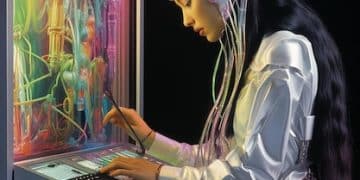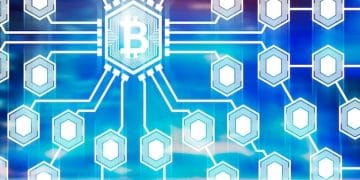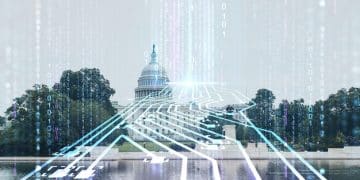Blockchain & Art: US Authentication and Ownership Guide

Blockchain technology offers a revolutionary solution for verifying authenticity and ownership of digital art in the US, providing artists and collectors with a transparent and secure platform for transactions and provenance tracking.
In the ever-evolving landscape of digital art, the need for secure authenticity and ownership verification is paramount. Blockchain and art: Verifying authenticity and ownership of digital art in the US is now achievable, offering a transparent and immutable system to protect creators and collectors alike.
Understanding Blockchain’s Role in Art Authentication
Blockchain technology is revolutionizing various industries, and the art world is no exception. Its inherent characteristics of transparency, security, and immutability make it an ideal solution for addressing the long-standing issues of authenticity and provenance in the art market.
What is Blockchain?
At its core, blockchain is a decentralized and distributed digital ledger that records transactions across many computers. Each transaction is grouped into “blocks” that are chained together chronologically and secured using cryptographic principles.
How Blockchain Enhances Art Verification
By leveraging blockchain, artists can create unique digital identities for their artworks, recording key information such as creation date, ownership history, and any subsequent transactions. This transparent and tamper-proof record establishes a clear chain of provenance, making it exceedingly difficult for counterfeiters to operate.
Here are some benefits of using blockchain for art verification:
- Enhanced Transparency: All transactions and ownership details are publicly accessible and verifiable on the blockchain.
- Improved Security: The decentralized nature of blockchain makes it resistant to tampering and fraud.
- Streamlined Provenance Tracking: Blockchain provides an immutable record of the artwork’s history, simplifying provenance research.
- Increased Trust: The transparency and security of blockchain foster greater trust between artists, collectors, and art institutions.
In conclusion, blockchain provides a robust and reliable framework for verifying the authenticity and ownership of art pieces, enhancing trust and transparency in the US art market.
NFTs and Digital Art Ownership: A New Paradigm
Non-fungible tokens (NFTs) have emerged as a groundbreaking application of blockchain technology in the art world. These unique digital assets represent ownership of digital or physical items, revolutionizing how art is bought, sold, and collected.
The Rise of NFTs in Art
NFTs enable artists to tokenize their digital creations, such as images, videos, and music, creating verifiable scarcity and ownership on the blockchain. Each NFT is unique and cannot be replicated, making it a valuable collectible item.
Securing Digital Art Ownership with NFTs
By purchasing an NFT, collectors acquire verifiable ownership of the associated artwork, recorded immutably on the blockchain. This eliminates the risk of counterfeiting and provides a clear and transparent record of ownership history.
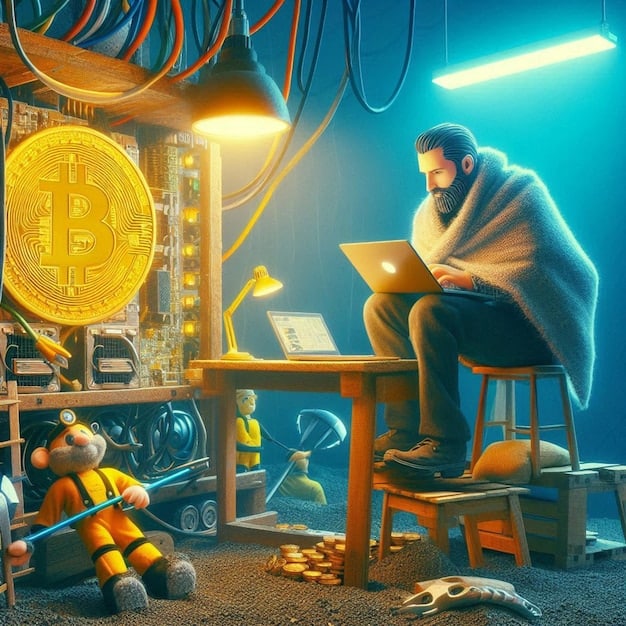
Consider the following advantages of using NFTs for digital art ownership:
- Authenticity Verification: NFTs provide irrefutable proof of authenticity and ownership, preventing fraud and counterfeiting.
- Direct Artist Compensation: Artists can receive royalties on secondary sales of their NFTs, fostering a more sustainable art ecosystem.
- Global Accessibility: NFTs enable artists to reach a global audience and collectors to acquire art from anywhere in the world.
- Enhanced Liquidity: NFTs can be easily traded on various online marketplaces, providing increased liquidity for art collectors.
In summary, NFTs are reshaping the digital art landscape by providing a secure and transparent mechanism for establishing ownership and supporting artists directly.
US Legal Framework for Blockchain and Digital Art
As blockchain technology gains traction in the art world, it is crucial to understand the existing US legal framework that governs digital art ownership, copyright, and smart contracts. This framework provides the foundation for the legal implications of blockchain and art: Verifying authenticity and ownership of digital art in the US.
Copyright Protection for Digital Art
In the US, copyright law protects original works of authorship, including digital art. Artists automatically acquire copyright protection upon creating their work, granting them exclusive rights to reproduce, distribute, and display their art.
Smart Contracts and Enforceability
Smart contracts are self-executing agreements written into code and stored on the blockchain. These contracts can automate the transfer of ownership, payment of royalties, and other terms associated with the sale of digital art. Enforceability may depend on jurisdiction and how well the smart contract adheres to existing legal principles.
Key considerations regarding the legal framework for digital art include:
- Copyright Infringement: Artists must be vigilant in protecting their copyright and taking action against unauthorized reproduction or distribution of their work.
- Smart Contract Disputes: As smart contracts become more prevalent, it is essential to consider potential disputes and ensure that contracts are drafted clearly and comply with applicable laws.
- Regulatory Uncertainty: The legal and regulatory landscape for blockchain and digital art is still evolving, requiring artists and collectors to stay informed of any relevant developments.
Overall, understanding the US legal framework is essential for navigating the legal complexities of blockchain and digital art, ensuring that artists’ rights are protected, and transactions are legally sound.
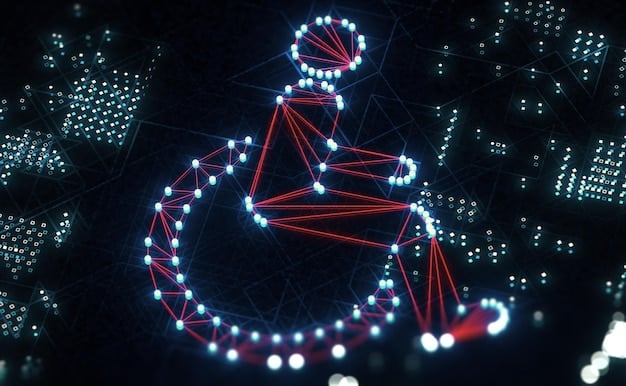
Challenges and Limitations of Blockchain in the Art World
While blockchain technology offers numerous benefits for art authentication and ownership verification, it is essential to acknowledge its limitations and challenges, especially in compliance with regulations such as General Data Protection Regulation (GDPR) and other similar compliance rules.
Scalability and Transaction Fees
Some blockchain networks can experience scalability issues, leading to slower transaction times and higher fees, especially during periods of high demand. This can make it costly to mint and trade NFTs, potentially hindering adoption.
Environmental Concerns
Certain blockchain networks, particularly those using a proof-of-work consensus mechanism, require significant amounts of energy to operate. This has raised environmental concerns, leading to calls for more sustainable blockchain solutions.
Regulatory Uncertainty
The regulatory landscape for blockchain and cryptocurrencies is still evolving in many jurisdictions. This uncertainty can create challenges for artists and collectors who wish to operate within a legally compliant framework. While the blockchain and digital art verification process offers enhanced security, artists and collectors should be aware of the potential compliance issues.
Some other potential challenges include:
- Storage Issues: Storing high-resolution digital art on the blockchain can be costly and inefficient.
- Lack of Interoperability: Different blockchain networks may not be compatible, making it difficult to transfer NFTs between platforms.
- Risk of Smart Contract Vulnerabilities: Smart contracts can contain bugs or vulnerabilities that can be exploited, leading to loss of funds or ownership.
Despite these challenges, ongoing development efforts are focused on addressing these limitations and improving the scalability, sustainability, and security of blockchain technology for the art world.
Best Practices for Artists and Collectors in the Blockchain Era
To effectively leverage blockchain technology for art authentication and ownership, artists and collectors should follow best practices that promote transparency, security, and legal compliance.
For Artists: Protecting Your Work on the Blockchain
Artists should take steps to protect their intellectual property rights when tokenizing their work on the blockchain. This includes registering copyrights, implementing watermarks, and using smart contracts that clearly define ownership and usage rights.
For Collectors: Due Diligence and Security Measures
Collectors should conduct thorough due diligence before purchasing NFTs, including verifying the authenticity of the artwork, researching the artist and platform, and understanding the terms and conditions of the sale. Security measures such as using hardware wallets and enabling two-factor authentication are also essential to protect digital assets.
Check out these best practices for artists and colectors:
- Use Reputable Platforms: Choose established and reputable NFT marketplaces that have security measures and user protections in place.
- Store Private Keys Securely: Protect your private keys, which are used to access and control your digital assets, by storing them offline in a hardware wallet.
- Stay Informed: Keep up-to-date with the latest developments in blockchain technology, regulations, and security best practices.
By following these best practices, artists and collectors can navigate the blockchain landscape more effectively, minimize risks, and maximize the benefits of this transformative technology.
The Future of Blockchain and Art: Predictions and Trends
The intersection of blockchain and art: Verifying authenticity and ownership of digital art in the US is poised for continued growth and innovation. Several key trends and predictions point towards a future where blockchain plays an increasingly pivotal role in the art world.
Increased Adoption of NFTs
As more artists and collectors embrace NFTs, we can expect to see further growth in the NFT market, with new use cases emerging beyond digital art. This includes tokenized ownership of physical artworks, fractional ownership, and decentralized autonomous organizations (DAOs) for art collecting.
Integration with Traditional Art Institutions
Traditional art institutions, such as museums and galleries, are beginning to explore the potential of blockchain technology to enhance their operations. This includes using blockchain to track provenance, verify authenticity, and create new engagement models for visitors.
Advancements in Blockchain Technology
Ongoing advancements in blockchain technology, such as layer-2 scaling solutions and energy-efficient consensus mechanisms, will address some of the current limitations and make blockchain more accessible and sustainable for the art world.
Emerging trends include:
- Metaverse Integrations: NFTs will increasingly be integrated into metaverse environments, allowing users to display and interact with their digital art collections in virtual spaces.
- AI-Generated Art: Blockchain can be used to verify the authenticity and provenance of AI-generated art, ensuring that creators are properly credited and compensated.
- Tokenized Art Funds: Blockchain-based art funds will allow investors to gain exposure to the art market more easily, with increased transparency and liquidity.
In conclusion, the future of blockchain and art: Verifying authenticity and ownership of digital art in the US is bright, with exciting developments on the horizon that will transform how art is created, collected, and experienced.
| Key Point | Brief Description |
|---|---|
| 🖼️ Art Authentication | Blockchain provides a secure way to verify the authenticity of digital art. |
| 🔑 NFT Ownership | NFTs enable verifiable digital art ownership. |
| ⚖️ Legal Framework | US copyright law applies to digital art; smart contracts manage ownership. |
| 🚀 Future Trends | Increased NFT use, integration with art institutions, blockchain advancements. |
Frequently Asked Questions
▼
Blockchain enables secure and transparent verification of art authenticity, making it nearly impossible to counterfeit artworks. This ensures trust between artists and collectors.
▼
NFTs provide a unique digital token representing ownership of an artwork. Each NFT is unique and stored on the blockchain, offering proof of ownership and provenance.
▼
Yes, digital art is protected under US copyright laws. Artists automatically obtain copyright protection once they create an original piece, giving them control over reproduction and distribution.
▼
Scalability, high transaction fees, and environmental concerns are challenges. Additionally, regulatory uncertainty and the risk of smart contract vulnerabilities must be considered.
▼
Artists should register copyrights, implement watermarks, and use smart contracts to clearly define ownership and usage rights. This helps safeguard their intellectual property on the blockchain.
Conclusion
In conclusion, blockchain and art: Verifying authenticity and ownership of digital art in the US presents a promising avenue for enhancing trust and security within the art ecosystem. While challenges remain, ongoing advancements and best practices are paving the way for a future where digital art transactions are transparent, secure, and accessible for all.
